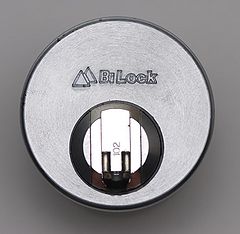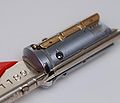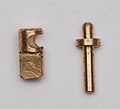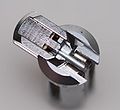BiLock QC
BiLock QC
| BiLock QC | |
 | |
| Name | BiLock QC |
|---|---|
| Manufacturer | Australian Lock Company |
| Lock Type | Cylinder |
| Lock Design | Slider, Sidebar |
| Year(s) Produced | 1998 - present |
| Patent | US 6,076,386 |
| Related Locks | |
| BiLock FG BiLock NG | |
The BiLock QC (or BiLock Quick Change) is the removable core version of the BiLock dual-sidebar locks (BiLock FG or BiLock NG) made by Australian Lock Company. QC cylinders use twelve pins arranged in two rows of six. Each row of pins uses a separate sidebar located at 3 and 9 o'clock in the plug.
Principles of operation
The BiLock QC uses a total of twelve pins arranged in two rows of six. Each row of pins interacts with a sidebar on each side of the plug. Each pin has a round hole, the true gate, and a false gate located two pin depths away from the true gate. The false gate is the same shape as the true gate, but is too shallow to allow the sidebar to fully retract. To open the lock, all pins are raised and the side bar legs retract into the true gate on each pin. There are 4 depths for pins, which allows 16,777,216 (412) theoretical key differs. Master keying is available by using pins with widened or multiple sidebar holes. Master keyed pins do not use false gates.
There is no MACS for BiLock pins, but two four depths (deepest key cut) cannot be opposite one another because it weakens the key.
The main difference between the classic BiLock FG and the NG is a moving element in the key. Similar to the component used in the Mul-T-Lock Interactive, this component in the key interacts with a movable element at the front of the lock, referred to as the "13th locking dimension" by BiLock advertising literature.[1] While at rest, the movable element connects to a blocking bar that prevents the sidebar at 3 o'clock from retracting. The moving element in the key raises the blocking bar so that the sidebar may retract. Unlike other interactive components, the BiLock's component does not use a shear line or other positive locking mechanism; it only needs to be moved up to function.
Notes
- BiLock keys are cut then folded to create their U-shape.
- The BiLock QC may use either BiLock FG or BiLock NG cylinders.
Disassembly instructions
The BiLock QC is easy to disassemble:
- Insert a working control key and rotate the plug 45° in either direction.
- Pull on the key to free the plug from the cylinder.
- To reassemble, insert the plug (with control key) into the cylinder at 45° then rotate the plug to the 12 o'clock position and remove the key.
Notes
- The QC sidebars are crimped in place to facilitate core removal.
- QC plugs have the cam mechanism as part of the plug; removal of a c-clip or other retainer is not necessary for disassembly.
Vulnerabilities
The BiLock QC may be vulnerable to one or more of the following:
Notes
- The BiLock QC cannot be bumped because it is does not use driver pins.
- User keys can be upgraded to control keys by material removal.[2]
- Decoding is possible via shimming of the pin channels as well as a pin & cam decoding tool from Falle Securities.[2]
- Visual key decoding is simplified due to the low number of depths per pin.
- Keys can be simulated with thin shims made of plastic or metal.[2]
Gallery
References
- ↑ Australian Lock Company. BiLock Sales Brochure
- ↑ 2.0 2.1 2.2 King, Jon & Datagram. (2011) Beating the BiLock











